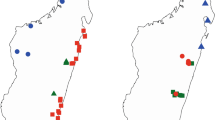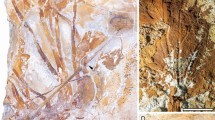Abstract
THE Nemataceæ embraces only two known species, namely, Ephemeropsis tjibodensis Goebel em. Fleischer, which is epiphyllous, ranging from Siam through the Indonesian Islands to New Guinea, and E. trentepohlioides (Renner1) Sainsbury2—until now believed endemic in New Zealand, where it is scattered through both islands, occurring on bark and twigs (of Rubus, Leptospermum, Fuchsia and Coprosma spp.). Both mosses are small and inconspicuous, with very remarkable gametophytes consisting almost entirely of matted, freely branched protonemal filaments which creep over the substrate. Normal foliage is represented by a single series of three or four minute nerveless leaves at the base of each female inflorescence (or seta, which may be several millimetres long). The differences between these species are fully discussed by O. Renner1 and G. O. K. Sainsbury2, and it seemed likely that one or other would eventually be found in eastern Australia.
This is a preview of subscription content, access via your institution
Access options
Subscribe to this journal
Receive 51 print issues and online access
$199.00 per year
only $3.90 per issue
Buy this article
- Purchase on Springer Link
- Instant access to full article PDF
Prices may be subject to local taxes which are calculated during checkout
Similar content being viewed by others
References
Renner, O., Ann. Jard. Bot. Buitenzorg, 44, 79 (1934).
Sainsbury, G. O. K., Trans. Proc. Roy. Soc., N.Z., 79, 203 (1951).
Author information
Authors and Affiliations
Rights and permissions
About this article
Cite this article
WILLIS, J. Nemataceæ, a Moss Family New to Australia. Nature 172, 127–128 (1953). https://doi.org/10.1038/172127a0
Issue Date:
DOI: https://doi.org/10.1038/172127a0
Comments
By submitting a comment you agree to abide by our Terms and Community Guidelines. If you find something abusive or that does not comply with our terms or guidelines please flag it as inappropriate.



